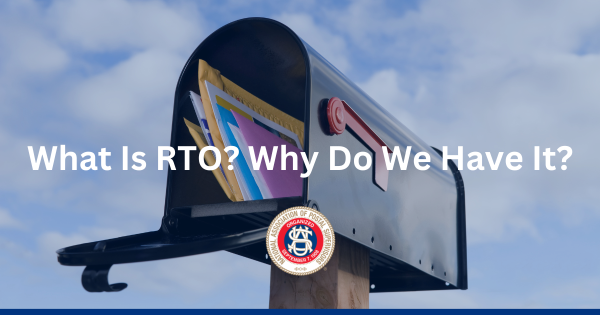What Is RTO? Why Do We Have It?
What Is RTO? Why Do We Have It?
By Dan Mooney
NAPS North Central Area Vice President
We all know the USPS has decided to fully implement the Regional Transportation Optimization (RTO) initiative on a national scale. The Postal Regulatory Commission (PRC) gave an advisory opinion against implementing RTO, saying it would have a negative impact on service, particularly in rural America. RTO also means the end to overnight Express Mail for 71% of the ZIP codes under the RTO umbrella.
Basically, RTO means if you are a smaller post office outside 50 miles from a processing center, you will not have your mail picked up at the end of the day. It will be picked up the next morning when mail is brought to be delivered that day. Mail taken in over the counter, mail brought back by carriers and mail collected from collection boxes will remain at the office until the next morning and be picked up and taken to be processed.
The plus to this initiative is it is supposed to save millions of dollars by eliminating PM dispatches in RTO offices. The negative is this initiative will slow down mail, mainly in rural America. It also will eliminate overnight Express Mail in many post offices.
Understand the impacts and theories behind this initiative. Approximately 71% of the country’s ZIP codes will be impacted by RTO; 29% will not be impacted. Approximately 47% of the nation’s population will be impacted who live in the 71% of impacted ZIP codes. Conversely, 53% of the nation’s population lives in the 29% of the ZIP codes not being impacted by RTO.
The USPS claims approximately 11% of the mail will have slower/lower service standards. This means the amount of mail generated in the 71% of ZIP codes and 47% of the population—which is rural America and impacted by RTO—makes up a relatively small portion of the overall mail volume.
Conversely, most of the U.S. mail volume is generated in the 29% of ZIP codes and 53% of the population (urban America) that will not be RTO. Bottom line, the USPS is banking it will save a lot of money to outweigh the negative service impact to a small amount of rural mail.
The USPS has lowered service standards to accommodate the impact of RTO. Customers and the general public are not made aware when RTO is implemented. They don’t know if they rush to the post office to mail something before it closes that it won’t go out that night; it will go out the next morning.
They won’t know if collection box pickup times are changed and, if the times are changed, what the new time is. They don’t know the mail in collection boxes picked up that night will sit in the post office overnight.
We should let customers know when their service has changed, how it’s changed and that we are doing it to save money and keep the company viable. Let’s all hope for the sake of the USPS that the savings outweigh the service impacts when all is said and done.
Hopefully, this has given you a better understanding of RTO, the rationale and impacts behind it. Keep the faith and stay on the high road, the view is much better!
